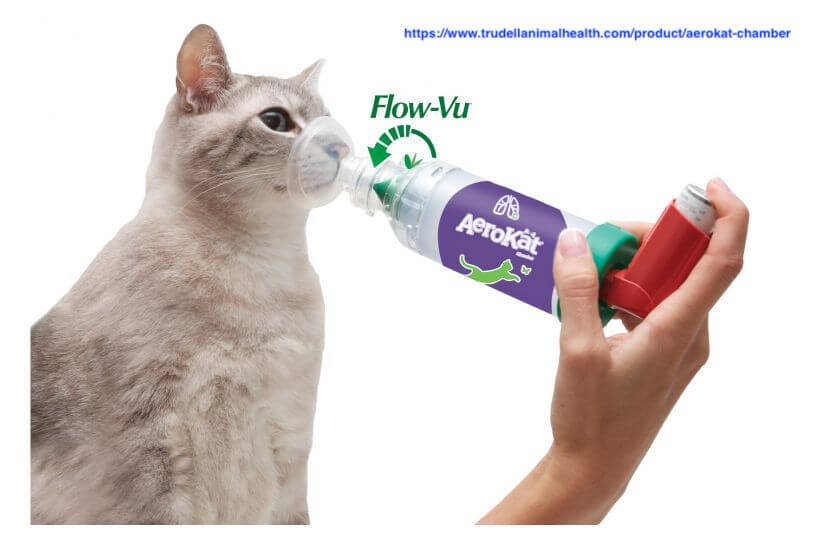Asthma in cats (also known as feline allergic bronchitis) is a common medical condition. Asthma is a condition that causes inflammation of the airways that arises from a hypersensitivity reaction, which leads to difficulty breathing. This article will talk about the symptoms of feline asthma and how it is treated. It will also educate pet owners on how they can spot potential symptoms that they might not have been aware of.
What causes asthma in cats?
Feline asthma is a result of a hypersensitivity reaction to various airborne allergens. The result of this hypersensitivity reaction is airway inflammation, mucous production, and air constriction and spasm. Dust, house dust mites, cigarette smoke, mildew, molds, weeds, trees, parasitic proteins, pollens, cat litter, powders, and household chemicals have all been linked to feline asthma.
As feline asthma can be caused by an allergic reaction to pollens and other airborne contaminants, some cats with asthma will only have seasonal symptoms.

What are the symptoms of asthma in cats?
Symptoms are divided into 3 phases: Acute, chronic, and intermittent. With acute clinical symptoms, cats often quickly present with respiratory distress with marked difficulty in breathing. You may notice this through open-mouth breathing with an abdominal effort. The majority of cats however will have chronic symptoms such as:
- Coughing; your cat may appear to be "coughing up a hairball"
- Wheezing
- Rapid or difficulty breathing
- Panting
- Nonspecific signs such as lethargy, lack of appetite and weight loss
What are the treatment options for asthma in cats?
The objective of treatment is to reduce environmental allergy exposure and airway inflammation. The treatment of acute respiratory distress and long-term maintenance therapy are two categories of therapy.
Emergency treatment for an acute asthma attack
If your cat is in severe respiratory distress it is extremely important to minimize handling and stress as this will exacerbate the symptoms. Your veterinarian will most likely provide some level of sedation so that oxygen can be delivered as stress-free as possible. Injectable medications or inhaled bronchodilators may also be administered to help open the airways and provide relief.
Maintenance therapy for feline asthma
Corticosteroids are the most effective therapy options. Corticosteroids work by reducing inflammation of the airways and therefore resulting in reduced constriction. Corticosteroids may be provided either orally or inhaled by using a puffer.
Once the asthmatic cat is stable, using inhaled corticosteroids is preferred as there are fewer side effects compared to oral corticosteroids. Human-type puffers can be used but there needs to be a proper delivery device. The device we use is the Aero-kat© chamber device. The puffer attaches to the Aero-kat© chamber and is then placed over the nostrils and mouth of the cat. Inhaled steroids are not completely effective until 1-2 weeks after treatment begins, therefore they are not used for emergency or initial therapy. Oral corticosteroids can be used for cats with asthma who either do not respond to the inhaler or if they become stressed with the Aero-kat chamber.


In cats that fail to respond to inhaled corticosteroids, if there are significant side effects with oral corticosteroids, or if your cat has diabetes and therefore cannot receive corticosteroids, cyclosporine has been used successfully.
How can you help your asthmatic cat?
Reduce exposure to allergens and irritants like house chemicals, air fresheners, potpourri, powders, and dust from kitty litter. Using a HEPA filter may also be useful. Frequently clean pet bedding and vacuum the home.
If your cat is showing any of these symptoms, it's important to get them diagnosed by a veterinarian. Asthma in cats can be caused by an allergic reaction to pollens and other airborne contaminants, so some cats will only have seasonal asthma. These signs may include open-mouth breathing with abdominal effort or coughing up a hairball. Cats that are struggling with chronic asthma often present with difficulty or rapid breathing along with coughing and lethargy. The treatment for asthma in cats includes reducing environmental allergy exposure and airway inflammation either through inhalers or corticosteroid tablets. If the asthmatic cat fails to respond well to corticosteroids therapy then cyclosporine may be used instead as their last resort option when all else has failed.


